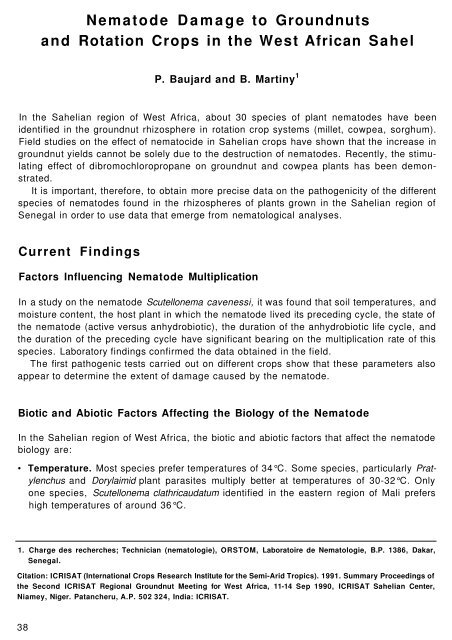RA 00183.pdf - OAR@ICRISAT
RA 00183.pdf - OAR@ICRISAT
RA 00183.pdf - OAR@ICRISAT
Create successful ePaper yourself
Turn your PDF publications into a flip-book with our unique Google optimized e-Paper software.
Nematode D a m a g e to Groundnuts<br />
and Rotation Crops in the West African Sahel<br />
P. Baujard and B. Martiny 1<br />
In the Sahelian region of West Africa, about 30 species of plant nematodes have been<br />
identified in the groundnut rhizosphere in rotation crop systems (millet, cowpea, sorghum).<br />
Field studies on the effect of nematocide in Sahelian crops have shown that the increase in<br />
groundnut yields cannot be solely due to the destruction of nematodes. Recently, the stimulating<br />
effect of dibromochloropropane on groundnut and cowpea plants has been demonstrated.<br />
It is important, therefore, to obtain more precise data on the pathogenicity of the different<br />
species of nematodes found in the rhizospheres of plants grown in the Sahelian region of<br />
Senegal in order to use data that emerge from nematological analyses.<br />
Current Findings<br />
Factors Influencing Nematode Multiplication<br />
In a study on the nematode Scutellonema cavenessi, it was found that soil temperatures, and<br />
moisture content, the host plant in which the nematode lived its preceding cycle, the state of<br />
the nematode (active versus anhydrobiotic), the duration of the anhydrobiotic life cycle, and<br />
the duration of the preceding cycle have significant bearing on the multiplication rate of this<br />
species. Laboratory findings confirmed the data obtained in the field.<br />
The first pathogenic tests carried out on different crops show that these parameters also<br />
appear to determine the extent of damage caused by the nematode.<br />
Biotic and Abiotic Factors Affecting the Biology of the Nematode<br />
In the Sahelian region of West Africa, the biotic and abiotic factors that affect the nematode<br />
biology are:<br />
• Temperature. Most species prefer temperatures of 34°C. Some species, particularly Pratylenchus<br />
and Dorylaimid plant parasites multiply better at temperatures of 30-32°C. Only<br />
one species, Scutellonema clathricaudatum identified in the eastern region of Mali prefers<br />
high temperatures of around 36°C.<br />
1. Charge des recherches; Technician (nematologie), ORSTOM, Laboratoire de Nematologie, B.P. 1386, Dakar,<br />
Senegal.<br />
Citation: ICRISAT (International Crops Research Institute for the Semi-Arid Tropics). 1991. Summary Proceedings of<br />
the Second ICRISAT Regional Groundnut Meeting for West Africa, 11-14 Sep 1990, ICRISAT Sahelian Center,<br />
Niamey, Niger. Patancheru, A.P. 502 324, India: ICRISAT.<br />
38

















